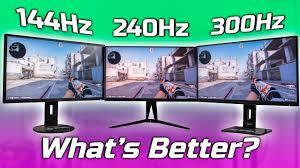
So, you’ve snagged yourself a shiny new 144Hz monitor, boasting about its super-fast refresh rate. But how do you actually know it’s working at its full potential? Fear not, fellow tech adventurer, because this guide will equip you with the knowledge to test your 144Hz screen and unlock its buttery-smooth visuals.
Why High Refresh Rates Matter
Imagine watching a movie where each frame appears choppy and jittery. Not exactly a cinematic experience, right? That’s where refresh rate comes in. It refers to the number of times your monitor refreshes the image on the screen per second, measured in Hertz (Hz). Standard monitors typically have a 60Hz refresh rate, meaning the image updates 60 times a second. A 144Hz monitor doubles that, providing a smoother, more fluid viewing experience.
This is especially crucial for fast-paced activities like gaming. In competitive shooters, every millisecond counts you can track your opponents with razor-sharp precision when you use a high refresh rate test. It also reduces screen tearing, that annoying effect where the image appears to be ripped apart. Basically, a 144Hz monitor makes everything feel noticeably more responsive and visually pleasing.
Types of High Refresh Rate Tests
There are two main ways to test your 144Hz monitor:
Checking Your Settings: This is the easiest method. Head over to your monitor’s on-screen display (OSD) menu, usually accessed by buttons on the monitor itself. Navigate through the settings to find the refresh rate option. It should be set to 144Hz for optimal performance. You can also check your operating system settings. On Windows, right-click your desktop, select “Display settings,” then “Advanced display.” Look for the “Choose a refresh rate” dropdown and ensure its set to 144Hz.
Online High Refresh Rate Tests: Several online tools can help you visually assess your monitor’s refresh rate capabilities. A popular option is the UFO Test (https://blurbusters.com/category/testufo/). This website displays a UFO animation that moves across the screen at varying speeds. At 144Hz, the UFO should appear clear and distinct with minimal motion blur.
Step-by-Step Guide to Testing Your 144Hz Monitor
Here’s a breakdown of how to test your 144Hz monitor using both methods:
Checking Settings
Access your monitor’s OSD menu. Consult your monitor’s manual for specific instructions on how to navigate the menu.
Locate the refresh rate setting. Look for options like “Display Settings” or “Refresh Rate.”
Ensure the refresh rate is set to 144Hz.Select the 144Hz option from the available choices.
Online High Refresh Rate Test
Head over to the UFO Test website ([https://blurbusters.com/category/testufo/](https://blurbusters.com/category/testufo/)).Make sure you’re using a web browser that supports high refresh rates.
Run the UFO animation test. Click the “Play” button to start the animation.
Observe the UFO’s movement. If your monitor is running at 144Hz, the UFO should appear clear with minimal blur as it moves across the screen. You may also see additional test options like a persistence trail test, which helps identify ghosting issues.
Conclusion
By following these steps, you can verify that your 144Hz monitor is functioning as intended. Remember, a high refresh rate test is just the first step. To fully experience the benefits of 144Hz, ensure your graphics card can output frames at a high enough rate to match the monitor’s refresh rate. Additionally, make sure games and other applications you use are configured to utilize the full 144Hz potential.
Now, go forth and enjoy the silky-smooth visuals your 144Hz monitor has to offer! Whether you’re dominating the competition in online games or simply scrolling through webpages, you’ll appreciate the newfound responsiveness and clarity.
FAQs
My monitor says it’s 144Hz, but the test shows otherwise. What’s wrong?
There could be a few reasons. Double-check your monitor and operating system settings to ensure 144Hz is selected. Additionally, some games or applications may have their own refresh rate settings that need to be adjusted.